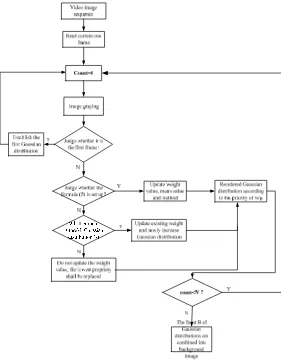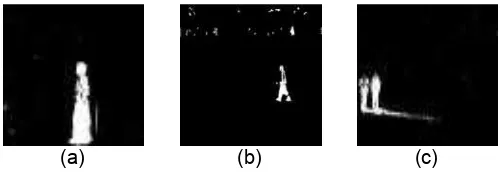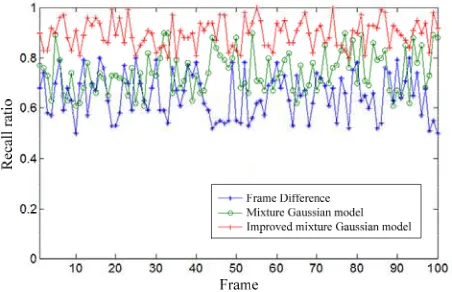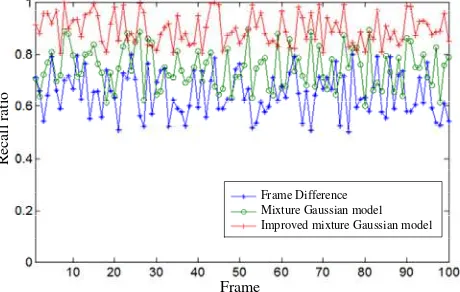DOI: 10.12928/TELKOMNIKA.v14i3A.4435 229
Small Moving Target Detection Model Based on
Improved Mixed Disturbance Gauss Model
Ting Bai*1, Jinwen Tian1, Xiao Sun1 1
National Key Laboratory of Science & Technology on Multi-spectral Information Processing, School of Automation, Huazhong University of Science and Technology, Wuhan, 430074, China
*Corresponding author, e-mail: [email protected]
Abstract
In order to obtain ideal moving target detection results, a kind of moving target detection algorithm of improved mixture Gaussian model is proposed in this paper on the basis of analyzing the deficiency of traditional Mixture Gaussian model. Firstly, in this algorithm, the update rate is increased to better adapt to the change of environment and the idea of pixel connected region is introduced to remove the noise, then the invariance property of chroma is adopted to avoid arising of “shadow” phenomenon; finally, simulation comparison experiment is used to test its performance. The experiment results show that this algorithm can generate reliable background image and accurately and completely detect the moving target to obtain more superior detection results of comparison algorithm, which can meet the practical application requirement of target tracking.
Keywords: gaussian mixture model; target tracking; learning rate; shadow inhibition
Copyright © 2016 Universitas Ahmad Dahlan. All rights reserved.
1. Introduction
forward some improved mixture Gaussian models to improve the accuracy of moving target detection [9-11]. Specific to the existing defects for mixture Gaussian model and considering improving the accuracy of the moving target detection as the goal, moving target detection algorithm based on improving mixture Gaussian model is put forward in this paper. First, this algorithm increases the update rate to better adapt to environment change and introduce the idea of pixel connected region to estimate the noise, then make use of the invariance property of chroma to avoid arising of “shadow” phenomenon, it is compared with other moving target detection algorithm for testing to test the validity and superiority of the algorithm in this paper.
2. Mixture Gaussian Model 2.1. Background Modeling
Mixture Gaussian model is the background modeling technology based on pixel point, and it takes each pixel point as a random variable to establish kth Gaussian distribution for them to describe the background value of the pixel point. For any pixel point (x, y), its sequence of historical pixels can be described as:
1 2
{x ,x ,,xt}{Ii( ,x y) , 1 i t} (1)
In the formula, Ii(x,y) refers to the gray value at ith moment.
At the moment t, computational formula of probability function of pixel point (x, y) is:
, , ,
1
( ( , )) ( ( , ), , )
K
t i t t i t i t
i
P I x y w I x y
(2)In formula, wi,t is the weight valve of ith model at moment t; , is the mean valve of ith Gaussian distribution at the moment t; , , , Σ, is the probability density function at the moment t, its computational formula is:
1 , , , , , 1 ( ( , ) ) ( ( , ) ) 2
2 1 2 ,
( ( , ), , )
1 (2 ) | |
T
t i t i t t i t
t i t i t
I x y I x y
n i t I x y
e
(3)
2.2. Parameter Updating
Sequence the Gaussian distribution of frame pixel value Ii(x,y) according to the size of priority, if it meets the condition of formula (4), it shows whether it matches the Gaussian distribution or not; if it is succeeded in matching, the first parameter matched with Gaussian distribution shall be updated by formula (5)~(8); if it fails in matching, other parameters are not changed and the weight value shall be updated by formula (9).
1 , 1 , | ) , (
|It x y uit Dit (4)
, (1 - ) , -1
i t i t
w w (5)
, -1
(1 - ) i t Ii( ,x y)
(6)
2 2
, , -1
, -1 , -1
(1 - )
( ( , ) - ) ( ( , ) - )
i t i t
T
t i t t i t
I x y I x y
(7)
, (It( ,x y) | , i t)
(8)
, (1 ) , 1
i t i t
In this formula, αis learning rate;β is update rate.
2.3. Generation of Background and Extraction of Moving Target
After establishing corresponding mixture Gaussian model for each pixel, of which a part can be used to describe the background, the rest of Gaussian distributions are used to describe the foreground; Gaussian distribution is sequenced in descending order by w/μ value, so Gaussian distribution that is likely to represent the background may be arranged in the former of the sequence, the first B number of Gaussian distributions can be selected as the background model, and the details of it are shown as follows:
, 1
arg min( )
b
i t
b i
B w T
(10)In which, T is scheduled threshold value.
In actual application, if the value of T is too small, single Gaussian distribution may be used to describe the background, or multiple Gaussian distributions may be used to describe the background. T is defined as 0.75 in this paper.
2.4. Extraction of Moving Target
After selecting B Gaussian models, the current pixel value shall be used to match the generated background, if it does not match, the pixel point can be considered as moving target, or this pixel point is considered as background point, which can achieve the inspection of moving target.
From above, we can know that the workflow of traditional Gaussian model is shown as Figure 1.
Figure 1. Workflow of traditional gaussian model
3. Improvement of Mixture Gaussian Model 3.1. Improvement of Update Rate
rate β is too small, “blackspot” can remain in original position after the target is extracted from the scenario. According to operating principle of traditional mixture Gaussian model, we can know that βis determined by learning rate and probability density function, therefore, the β is enlarged by k times in this paper to avoid the arising of “blackspot” phenomenon.
,
( ( , ) | ,
t i t)
k
I x y
(11)3.2. Improvement of Learning Rate
Learning rate α is closely related to the update of background model, if its value can adapt to the environmental change for a long time, the moving target can be misjudged easily or the moving target can be lost easily. Therefore, a kind of self-adaptive learning rate is proposed in this paper, its computational formula is shown as follow:
2
1
, 1
2 (1 D ),
n N n C
C e n N
(12)
In this formula, n is the frame number of video; N is the first N; both of C1, C2 are constant;
D
is the difference of each pixel and adjacent 8 pixel values; its computational formula is shown as follows:
1 1 1 1)]
,
(
)
,
(
[
9
1
i jj
y
i
x
B
j
y
i
x
I
D
(13)3.3. Noise Removal Point
Eight-neighborhood noise removal method is used for removing the noise; the details of it are shown as follow:
(1) In the detected binary picture, only considering “white dot” pixel, computing the number of “white point” that belongs to eight-neighborhood of “white point” pixel, if the number of it is less than 6, it can be defined as noise, which shall be eliminated.
(2) Moving target region can be obtained by closing first and then starting computing.
3.4. Shadow Elimination
In the process of target moving, a lot of “shadow” can be generated, so that there are unnecessary links generated between targets, which have an adverse impact on subsequent target tracking; therefore, the “shadow” phenomenon shall be avoided as much as possible. Invariance property of chromacity between shadow and pixel of background is used to eliminate the shadow; the details of it are shown as formula (14).
255, | | & & | | ( , )
0 ,
I B S I B H
S S T H H T
M x y
otherwise
(14)
In this formula, Th, Ts respectively refers to threshold value of chromacity and colour purity.
3.5. Step to Establish Background
(1) Read current one frame; as colour video is only collected at present, the graying shall be disposed for it, and the details of it are shown as follow:
( , )
0.11
( , )
0.59
( , ) 0.3
( , )
Gray i j
R i j
G i j
B i j
(15)(2) If the front frame is the first frame, establish the first Gaussian distribution, or carry out the following steps.
(3) The Gaussian distribution of frame pixel value Ii(x,y) shall be sequenced by the size of priority, if it meets the condition in formula (4), update the parameters according to formula (5)~ (8) and skip to step (5).
(4) If the number of Gaussian distribution meets preset number, update weight value according to formula (5) and add a new Gaussian distribution, and the weight value shall be computed by formula (6).
1, , 1
1
k
k t i t
i
w
w
(16)(5) If it does not reach the maximum number of frames, return to step (1) to proceed, or take current frame as Ii-1(x,y).
(6) The first B number of Gaussian distributions is elected as the background model, so as to obtain binary picture of moving target before the noise removal.
(7) The binary picture after the noise removal can be obtained through the noise removal processing and proper morphological open-close operation for the binary picture.
(8) For the binary picture after noise removal, eliminate the shadow of it by formula (14), so as to obtain the background image.
From above, we can know that the workflow of improved mixture Gaussian model is shown in Figure 2.
4. Simulation Experiment 4.1. Data Source
In order to test the performance of moving target detection algorithm of improved Gaussian model, Visual C++6.0 and Open CV as development tools are used to do simulation experiment on Window 7 operating system with Intel dual-core 2.75GHz CPU, 5 GB internal storage; the frame difference and traditional mixture Gaussian model are used to make control experiment to comparatively analyze its advantages and disadvantages from qualitative and quantitative aspects; this experimental data includes three groups of test video, which are respectively shown as Figure 3.
[image:6.595.173.426.221.301.2](a) (b) (c)
Figure 3. Experimental data
4.2. Result and Analysis
(1) Qualitative analysis: Test results of frame difference, mixture Gaussian model and improved mixture Gaussian model are as shown in Figure 4~6. The below conclusion can be obtained by comparing and analyzing Figure 4~ 6:
1) Frame difference is sensitive to noise and there are amount of errors, so that the moving target detection is not complete and there are a large amount of cavities.
2) Mixture Gaussian model can effectively remove part of noise, the moving target detection is reactive complete, but it cannot respond to the shift of object in time; there is “shadow” phenomenon for moving target detection results.
3) The test results of improved mixture Gaussian model test is the most superior, it can greatly remove the adverse influence of the noise; the edge of moving target is smooth, it fills up the cavity occurring in inspection results of frame difference and obtains compete moving target and better robustness than comparison algorithm.
[image:6.595.172.425.519.604.2](a) (b) (c)
Figure 4. Experimental result of frame difference
(a) (b) (c)
[image:6.595.173.424.647.734.2](a) (b) (c)
Figure 6. Experimental result of improved mixture gaussian model
(2) Quantitative analysis: In order to better comprehensively analyze the moving target detection results and make quantitative analysis for improved mixture Gaussian model, the recall ratio (Recall) and precision ratio (Precision) are selected as the evaluation index to inspect the advantages and disadvantages of the results, and they are respectively defined as follows:
Re
call
TP
TP
FN
(17)Pr
ecision
TP
TP
FP
(18)In this formula, TP is the number of correct pixel of inspection target; FP is the number of pixel by wrongly inspecting the background as the target; FN is the number of pixel by wrongly inspecting the moving target as the background.
Recall, Precision of test results of frame difference, mixture Gaussian model and improved Gaussian model are respectively shown in Figure 7 and Figure 8. From the Figure 7 and 8, we can know that various performance indexes of improved mixture Gaussian model are superior than that of frame difference and mixture Gaussian model, which obtains more ideal moving target detection results; contrast experiment results show that improved mixture Gaussian model can adapt to the moving target detection in complex environment and better make for subsequent moving target tracking.
Frame
Recall ratio
Frame Difference Mixture Gaussian model Improved mixture Gaussian model
Figure 8. Variation curve of precision ratio of different algorithms
5. Conclusions
On the basis of deeply analyzing mixture Gaussian model, a kind of moving target detection algorithm of improved mixture Gaussian model is proposed in this paper; firstly, update rate of mixture Gaussian model is increased to better adapt to the change of environment and; it has introduced the idea of pixel connected region to effectively remove the noise, then the invariance property of target chromacity is used to avoid the arising of the “shadow” phenomenon; finally, the simulation experiment results show that the moving target detection algorithm in this paper can generate reliable background image to accurately detect moving target and obtain more superior detection result than other moving target detection algorithm, which has higher actual value.
Acknowledgements
The National Natural Science Foundation of China (NSFC) projects under Grant No.61273279 and the National Natural Science Foundation of China (NSFC) projects under Grant No.61273241.
References
[1] Wenhua Huang, Yishuang Geng. Identification Method of Attack Path Based on Immune Intrusion Detection. Journal of Networks. 2014; 9(4): 964-971.
[2] Jie He, Yishuang Geng, Fei Liu, Cheng Xu, CC KF. Enhanced TOA Performance in Multipath and NLOS Indoor Extreme Environment. IEEE Sensor Journal. 2014; 14(11): 3766-3774.
[3] Na Lu, Caiwu Lu, Zhen Yang, Yishuang Geng. Modeling Framework for Mining Lifecycle Management. Journal of Networks. 2014; 9(3): 719-725.
[4] Vasanth PC, Nataraj KR. Facial Expression Recognition Using SVM Classifier. Indonesian Journal of Electrical Engineering and Informatics. 2015; 3(1): 16-20.
[5] Leela Kumari B, Padma Raju K. Performance Evaluation of Unscented Kalman Filter for Gaussian/non-Gaussian Tracking Application. International Journal of Electrical and Computer Engineering (IJECE). 2013; 3(1): 93-101.
[6] Jinyu Hu, Zhiwei Gao. Distinction immune genes of hepatitis-induced heptatocellular carcinoma. Bioinformatics. 2012; 28(24): 3191-3194.
[7] Blazek P, Kolb M, Partl M, et al. The usage of social media applications in product configurators. International Journal of Industrial Engineering and Management (IJIEM). 2012; 3(4): 179-183. [8] Li M, Fan J, Zhang Y, Zhang R, Xu W, Hou D. A Moving Object Detection Algorithm Based On
Multiple Judgments. TELKOMNIKA Indonesian Journal of Electrical Engineering. 2013; 11(10): 5539-5544.
[9] Cheng L, Bao W. Remote sensing image classification based on optimized support vector machine. TELKOMNIKA Indonesian Journal of Electrical Engineering. 2014; 12(2): 1037-1045.
[10] Wang X, Zhang T, Chang C. A Moving Objects Detection Method with Resistance to Illumination Change. TELKOMNIKA Indonesian Journal of Electrical Engineering. 2014; 12(5): 3719-3727. [11] Wang XL, Li N. Study on interharmonics detection method based on windowed interpolation FFT




